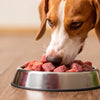Can Raw Food Make My Dog Constipated? Understanding the Risks and Solutions
- Houndsy
Table of Contents
- Introduction
- Understanding Raw Diets for Dogs
- Common Causes of Constipation in Dogs
- Identifying Symptoms of Constipation
- Effective Remedies and Management Strategies
- Preventing Future Constipation
- Conclusion
Introduction
Have you ever watched your furry friend struggle to do their business? It can be heart-wrenching. In fact, studies show that approximately 30% of dog owners have reported digestive issues with their pets at some point, particularly when making dietary changes. If you’ve recently transitioned your dog to a raw food diet and noticed signs of constipation, you’re certainly not alone. The question “Can raw food make my dog constipated?” frequently arises among pet owners who are navigating the complexities of this dietary shift.
As pet lovers, we all seek the best for our canine companions. Understanding how their diet—especially a raw one—affects their digestive health is pivotal. Throughout this blog post, we’ll delve into the implications of a raw diet, potential reasons behind canine constipation, and effective remedies to ensure your dog's digestive system stays on track.
We'll cover:
- What causes constipation in dogs, particularly in those eating raw diets.
- How the components of a raw diet impact digestion.
- Effective solutions to alleviate constipation.
- Tips for maintaining your dog’s digestive well-being.
By the end of this article, we hope to empower you with the knowledge to manage and prevent constipation in your dog, thereby enriching your pet's overall quality of life.
Understanding Raw Diets for Dogs
What is a Raw Food Diet?
A raw food diet for dogs, often referred to as a BARF diet (Biologically Appropriate Raw Food), is designed to mimic what a dog would consume in a wild environment. This diet typically includes:
- Raw meats
- Bones
- Offal (organ meats)
- Fruits and vegetables
This holistic approach aligns with a dog’s evolutionary biology, aiming to offer the nutritional components that higher-quality processed foods often lack.
Benefits of Raw Feeding
- Improved Coat Condition: Many pet owners report shinier and healthier fur coats in dogs switched to raw diets.
- Better Digestion: Raw food eaters often experience smaller, less odorous stools due to the increased digestibility of real meat.
- Increased Energy Levels: A raw diet can lead to heightened vitality, as dogs are able to ingest nutrients more effectively.
- Weight Management: Raw diets can keep dogs slim and fit, reducing the risk of obesity-related problems.
The Transition to Raw Food
Transitioning to a raw food diet should not be abrupt. Most veterinarians recommend a gradual switch over seven to ten days, mixing the new food with your dog’s previous meals to prevent digestive upsets.
Common Causes of Constipation in Dogs
Diet Imbalance
1. High Bone Content: While bones provide essential calcium and help clean teeth, they can also lead to harder stools if over-consumed. Raw diets should include only about 10% bone. Exceeding this ratio can lead to dry, crumbly feces that are hard to pass.
2. Insufficient Fiber: Fiber plays a crucial role in bowel movements. Dogs on a raw diet may not receive enough fiber, particularly if the diet lacks fruits and vegetables. Insufficient soluble and insoluble fiber can lead to constipation.
Dehydration
Dogs benefit from moisture in their food. Dry kibble diets are 8-10% moisture, while raw diets typically have 65-75% water content. If your dog isn’t receiving adequate water or moisture from food, it can cause their intestines to draw in more water from the stools, leading to harder feces.
Change in Diet
When dogs transition to raw foods after being on kibble, it’s common to experience digestive changes. The flavors and textures are markedly different, which can lead to temporary digestive hiccups, including constipation.
Stress and Environment
Stressful situations or changes in environment, such as moving homes or adjusting to new family members, can significantly affect a dog’s digestive system. This could hinder their ability to relax and successfully eliminate.
Medical Conditions
Certain medical conditions, such as hypothyroidism, diabetes, or neurological disorders affecting gut motility, can cause constipation. If dietary adjustments fail to improve your dog’s condition, it’s essential to consult a veterinarian.
Identifying Symptoms of Constipation
Knowing the signs of constipation will help you address the problem promptly. Symptoms include:
- Straining or difficulty defecating.
- Hard, dry stools that resemble pebbles.
- Abdominal discomfort or bloating.
- Lack of appetite or lethargy.
If your dog has not passed stool for more than 24-48 hours, it’s crucial to consult your veterinarian.
Effective Remedies and Management Strategies
Modify Your Dog’s Raw Diet
1. Adjust Bone Content: Monitor and reduce the quantity of bones in your dog’s diet. If your dog is constipated, consider replacing some bone-heavy meals with boneless protein options.
2. Add Fiber: Incorporate fiber-rich fruits and vegetables such as:
- Pumpkin
- Sweet potatoes
- Green beans
- Carrots These additions promote healthy bowel movement and soften stools.
3. Use Digestive Aids: Consider slippery elm bark or psyllium husk, which can help soothe the GI tract and add moisture to stool.
Ensure Proper Hydration
Always provide fresh water; consider supplementing your dog’s diet with bone broth or high-moisture options to support hydration.
Maintain a Routine
Establish a consistent daily schedule for feeding, walks, and potty breaks. Regular exercise not only contributes to your dog's overall health but also stimulates gut motility.
Preventing Future Constipation
- Monitor Body Weight: Keeping your dog at a healthy weight can reduce the risk of various digestive issues.
- Regular Vet Check-Ups: Regular visits to the veterinarian help catch potential health issues before they exacerbate.
- Maintain a Food Diary: Keeping track of what your dog eats and their bowel movements can help identify trends and needs for dietary adjustments.
Conclusion
As dog owners, we deeply care about our pets' well-being. While the transition to a raw food diet can come with its challenges, understanding the intricacies of your dog’s digestive health is invaluable. By being proactive, maintaining a balanced diet, and staying informed about the signs of constipation, we can ensure our furry friends thrive on a raw diet.
If you’re looking to elevate your dog-feeding ritual with a convenient, stylish solution, we invite you to explore the Houndsy Kibble Dispenser. Designed to simplify and enhance every feeding experience, it pairs perfectly with any diet, including raw.
FAQ
Can raw food lead to constipation in dogs?
Yes, a raw food diet can lead to constipation primarily due to excessive bone content, insufficient fiber, or a sudden diet change.
What adjustments should I make if my dog is constipated?
Reduce bone volume in their diet, add fiber-rich fruits and vegetables, and ensure they are well-hydrated.
How can I monitor my dog for healthy bowel movements?
Observing your dog’s stool consistency and frequency can help you understand their digestive health. Regular check-ins with your veterinarian can further aid in monitoring.
When should I consult a veterinarian about my dog’s constipation?
If your dog has not defecated for more than 48 hours or shows signs of discomfort, lethargy, or a loss of appetite, consult your veterinarian immediately.
Is it true that feeding raw can lead to less odor in dog stools?
Indeed, many dog owners report that their pets produce less smelly stools on a raw diet, attributed to the improved digestibility of whole, raw foods.
By focusing on the health of our loved pets, we create happier, healthier companions. Let's ensure our furry friends are thriving every day!













